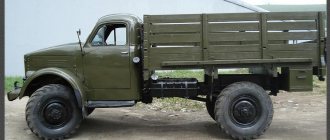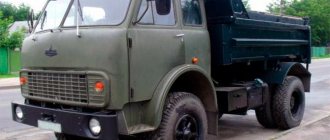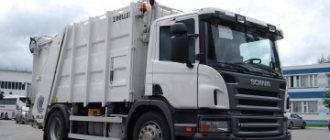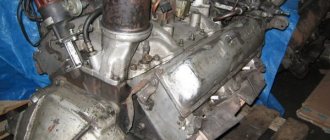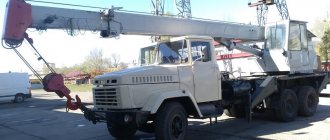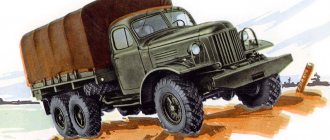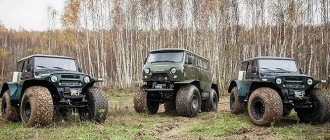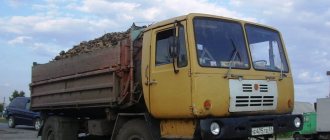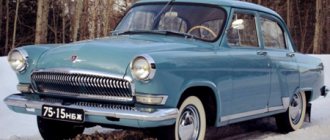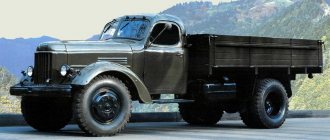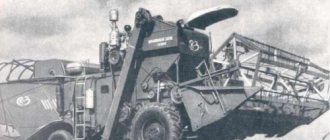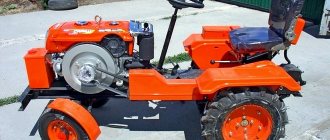About the history of this original model
The essence of the concept of a new series of three-axle off-road trucks, the first prototype of which was called ZIL-132K, was as follows: to combine the transmission and chassis of the special rescue all-terrain vehicle ZIL-4906/49061 “Blue Bird” with the cab and frame of an ordinary serial ZIL truck. As a result, we got a car that is no less passable, but much cheaper to produce and operate.
It is interesting that the roots of the “biography” of this model are not from the Ministry of Emergency Situations, but from the leaders of civil aviation of the Soviet Union. It was from this department that in 1989 the first request was received to consider the issue of creating cargo-passenger and cargo search and rescue vehicles for the search and rescue flight support service, with possible serial production of 250–300 such vehicles per year.
The talk was about creating a cheaper version of the legendary “Blue Bird”, developed at the ZILovsky SKB under the leadership of V.A. Grachev specifically for the evacuation of astronauts who returned to Earth in a hard-to-reach area. Civil aviation wanted a similar machine, but simpler, land-based, without the navigation function, but also with excellent maneuverability.
The appendix explained exactly what kind of cars they would like to have. For the cargo-passenger version, they wanted it to be able to transport up to 25 people, and for the cargo version, they wanted it to be equipped with a crane that lifts up to 3.4 tons and could carry at least 4 tons. Both vehicles had to be able to be transported by Il-76 transport aircraft and Mi-26 helicopters. The desired price for one truck was also indicated: 55 thousand rubles.
A few months later, in January 1990, the USSR Ministry of Energy expressed their readiness to purchase new promising all-terrain vehicles. They made a request for an all-terrain truck suitable for the construction and maintenance of power lines: transporting construction materials and equipment; teams involved in these works.
The State Committee for Emergency Situations (now the Ministry of Emergency Situations) joined this project only at the beginning of 1992, when the concept of this model had already taken shape, and voiced technical wishes for its version of an all-terrain truck - a vehicle for emergency rescue units.
The presence of several reputable customers predetermined the creation of a number of modifications of the ZIL-4972. But by the mid-90s, hard times had set in, so the promising all-terrain family never received proper development (eventually).
For several months in 1992, under the leadership of lead designer M.I. Sugrobov, a prototype of the ZIL-132K chassis was developed and manufactured. This new SUV, unlike the Blue Bird, did not float. But in comparison with the same ZIL-131, it had much stronger cross-country ability and maneuverability.
The initial pre-production ZIL-132Ks were equipped as follows: independent torsion bar suspension of the front and rear steered axles, a middle axle and a transmission from the famous “Blue Bird”. However, they were made much simpler and cheaper in terms of cost and production.
Instead of an aluminum frame, an ordinary one was used - made of a steel profile, instead of a high-tech fiberglass body, expensive and difficult to manufacture - a cabin from the usual ZIL-4331 or ZIL-4333 mass-produced trucks on the assembly line at that time. The engine was taken at that time, the most promising and “advanced”: diesel ZIL-645.
The first small-scale batches of these off-road trucks were manufactured by order of the State Committee for Emergency Situations (later became the Ministry of Emergency Situations, Ministry of Emergency Situations). And only then orders were placed by the Ministry of Civil Aviation and RAO UES of Russia (formerly the USSR Ministry of Energy).
"Blue Bird" and ZIL-4972
During operation in difficult off-road and weather-climatic conditions, ZIL-4972 trucks demonstrated serious superiority over many other multi-purpose off-road vehicles. And over tracked vehicles too.
Based on the results of this successful operating experience, rather “Napoleonic” plans were developed: launching the ZIL-4972 model into mass production, with the production of at least two thousand of these vehicles annually.
PZRA, the Pravdinsky Radio Relay Equipment Plant in the Nizhny Novgorod Region, was initially immediately involved in the direct implementation of this project. ZIL was already busy at that time. At a technical meeting held on March 30, 1992 at ZIL, it was decided to establish a separate special JSC "All-terrain vehicle GVA", whose tasks included the development and coordination of complete sets of manufactured vehicles with customers, monitoring the timely provision of all necessary design documentation from ZIL to PZRA and the sale of ready-made cars for customers.
The ZIL-4972 still had a good chance to come into constant use by oil workers: in 1997, AK Transneft became interested in this model. But it, too, was not properly implemented.
In total, from 1995 to 1999. ZIL and PZRA produced only about forty ZIL-497200 and ZIL-497205 vehicles. Until they became obsolete and written off, they were effectively used in all kinds of rescue and restoration work; when delivering repair, rescue teams and various special equipment in severe off-road conditions.
However, the enterprises did not receive either new orders or previously planned funds for the development of full-scale mass production of this off-road family.
ZIL-4972 vehicles, which can now be found in private car collections, usually have served in the Ministry of Emergency Situations in the past as a special vehicle designed for the prompt delivery of a rescue team with special equipment to the area of man-made and natural emergencies - to perform emergency rescue operations. They have low mileage and are in good condition. And taking into account the restoration and restoration carried out, they look even more cheerful.
The scrapped ZIL-4972 trucks were replaced by ordinary KamAZs and Urals - excellent equipment, but still not so “advanced” in cross-country ability.
Turbine instead of diesel
0
Source:
One of the pages of the history of Soviet military vehicles was written by unique heavy-duty trucks with gas turbine engines (GTE), which were a fashionable and promising trend at that time. For the first time such a car was assembled by the Bryansk Automobile Plant in 1968. It was a four-axle special chassis E135G for missile systems with a gas turbine with a power of 395 hp. With. Then, under the leadership of Vladimir Vladimirovich Tabolin, the design of such equipment was carried out by SKB-2 of the Kremenchug Automobile Plant using the chassis of the KrAZ-260 army truck. The first to appear in 1974 was the KrAZ-E260E prototype with a two-stage 350-horsepower gas turbine engine GAZ-99D, which had less toxicity, increased efficiency and half the weight of a conventional YaMZ-238 diesel engine. At the same time, in operating mode the power unit spun up to 33 thousand revolutions per minute. To reduce them, it was necessary to install a special clutch, gearbox and heavy gearbox in the transmission, which reduced the speed to 2,000–2,500 rpm. Externally, this car stood out with a wide radiator and an elongated rectangular hood. As tests showed, the weak link of the car turned out to be the complex transmission chain, which could not withstand the loads. A gas turbine was placed under the wide hood of the KrAZ-E260E truck
0
Source:
Two-stage gas turbine unit GAZ-99D with a power of 350 hp. With.
0
Source:
At the end of 1976, the second sample of the KrAZ-2E260E was assembled with a more compact and economical GAZ-99DM gas turbine engine of 360 liters. s., which fit into a standard engine compartment. Compared to the serial KrAZ-260 truck, fuel consumption was reduced by 40%. From the outside, the car was distinguished by wide and tall exhaust pipes on both sides of the car behind the cabin. And again, the transmission turned out to be unprepared for too high speeds: during the very first tests, the gearbox “flyed”. In the early 1980s, the project was closed, but the most powerful traction gas turbine engines continued to be mounted on multi-axle rocket chassis. Testing of an experimental gas turbine truck KrAZ-E260E. 1974
0
Source:
The second version of the KrAZ-2E260 with a 360-horsepower gas turbine. 1976
Modification options
At the end of 1992, the new SUV was put through extensive testing, and it convincingly proved its viability. And next year, the ZIL plant has already formed a family of trucks made on such an aggregate base. It included 4 modification options:
- ZIL-497200 – with a cargo-passenger van body (kung) for teams of workers and rescuers;
- ZIL-4973 - with a “bunker” lift from the “Blue Bird” special vehicle, which had a side unloading;
- ZIL-4974 - with a kung van - a “gait” for repair teams of power engineers and other workers;
- ZIL-497202 – flatbed truck with a single-row cabin and a crane-manipulator located between the cabin and the cargo platform;
- ZIL-4975 - a truck with an onboard platform and a crane on it, which was installed behind it;
- ZIL-497204 – flatbed truck with a single-row cabin and a crane-manipulator mounted in the rear;
- ZIL-497205 – cargo-passenger version, with a two-row cabin designed for 7 people, and a crane-manipulator installation between the cabin and the cargo platform.
Also, as a “piece product”, a modification of the ZIL-4972N was released - with a Caterpillar-3116 diesel engine (CAT-3116). It was delivered to Petropavlovsk-Kamchatsky by special order and worked in Kamchatka.
Around the capsule and TB
It has long been no secret that the ZIL used a unique armor technology - the car body was built around a volume-bearing armored capsule manufactured at a military plant in Kurgan.
The service life of the capsule exceeded the service life of the body, so the car, written off from the Special Purpose Garage, was returned to the factory, where a new body was made around the old capsule. In addition, the armored version had multi-layer self-tightening fire and explosion-proof fuel tanks. Naturally, such work was incredibly expensive for the state budget (in total, 25 armored capsules were manufactured, which were used in the construction of about a hundred cars and two for ballistic tests).
In the mid-1990s, the customer set a new task: in addition to traditional armor, to develop a cheaper armored version, albeit with a lower protection class, but using traditional technology for using protective armor plates in the most vulnerable affected areas. The German company Trasco Bremen got down to business, producing 3 prototypes that received the index 41047TB (Trasco Bremen). After testing these cars by the customer, all of them were returned to the factory due to unsatisfactory body rigidity, leaky handling and directional stability, as well as insufficient braking system efficiency. Our factory bureau had to return these cars to service. In essence, this meant modifying the frame, chassis and braking system of the “light” 41047, which was suddenly loaded with armor plates. In general, voluminous technical information about these exclusive one-piece cars is now available in many open sources; there are even individual drawings on the World Wide Web! That is why, perhaps, it will be more interesting to recall a few everyday life from the life of test drivers of the AMO ZIL passenger bureau.
Design features of ZIL-4972
From the serial ZIL-4331 truck, which replaced the famous ZIL-130 on the conveyor belt of the Likhachev Plant, the three-axle all-terrain vehicle ZIL-4972 took two cab options (single-row for the cargo-passenger version, double-row for the “clean” truck; power unit – ZIL-diesel engine 645 with a power of 185 horsepower; a nine-speed gearbox ZIL-4421. Everything else in the transmission, suspension and chassis of the all-terrain vehicle was taken from the ZIL-4906 - that very “Blue Bird". As a result, it was lightweight, simplified and deprived of the ability to swim , but an exceptionally high-pass option.
To achieve synchronization with the “donor” units, the gear ratios in the box were changed, and in total the inherited transmission included: a gearbox, a transfer case, final and wheel drives, and cardan drives.
The steering was equipped with two hydraulic boosters designed to turn the wheels of the front and rear axles, and a retarding mechanism for turning the axles.
Similar to the Blue Bird, on the ZIL-4972, when moving on soft soils, the wheels of the rear axle followed almost the path of the front wheels, providing cross-country ability that is unattainable for all-terrain vehicles with a single steered axle.
The basic equipment of the car included a preheater. They could heat the cabin when the engine was not running. As well as an electric torch device. The passenger compartment could be heated by a separate heater; was equipped with a stove for cooking and heating food.
A self-pulling winch was integrated into the front bumper, which was driven by a driveshaft from the power take-off. The electrical equipment system was divided into 2 subsystems - the first, with a voltage of 12/24 V, provided the engine, and the second (24 V) provided additional consumers. Each of these two subsystems had 2 batteries.
During testing and direct operation, the ZIL-4972 performed exceptionally well. All sorts of minor improvements were carried out over the course of 2-3 years, but overall this car came together almost immediately.
Off-road, it was superior in terms of specific traction force to KamAZ trucks comparable to it in terms of weight and technical characteristics. Also, the ZIL-4972 could develop greater speed off-road, had a smaller turning radius (about 10 m), and where KamAZ trucks had difficulty driving and got stuck even when moving straight, the ZIL-4972 could move by maneuvering.
The highest speed of the ZIL-4972 reached 82.4 km/h, acceleration time to 60 km/h was 31.3 seconds. The static lateral stability angle of this truck is 39°26′. ZIL-4972 calmly and confidently overcame steep climbs from 18.3 to 28.3° on soggy loamy soils and loose sand.
The control consumption of diesel fuel when driving on a dry concrete road at a speed of 50 km/h was demonstrated to be around 25 liters per 100 km, and the range was a thousand kilometers. The operating consumption of diesel fuel on a dry asphalt highway was 36 l / 100 km, on a wet primer - 55 l / 100 km, off-road, on rough terrain - 101 l / 100 km, on virgin snow more than 40 cm deep - 330 l / 100 km .
Threat to the USA
“Running elk” lived in the Perm region for a year. And only after a wide variety of trials did he return to Moscow. And soon he was given a new task - he was loaded with blanks for spare parts with a total weight of four tons and sent to the Serdobsky Machine-Building Plant, which was located in the Penza region. And then ZIL returned back, delivering processed blanks to his home enterprise.
After this, the ZIL-E167 was subjected to forced marches several times over the harshest Soviet off-road conditions. After testing with snow, it was tested for survival in hot sand and marshy swamps. And ZIL coped. He even took part in the construction of the new Shaim – Tyumen oil pipeline. A little later, the truck was transferred to the most inaccessible taiga areas, where the temperature often dropped to -40 degrees.
It was then that the ZIL-E167 was noticed by American satellites. There, overseas, they thought that the USSR was testing some new military all-terrain vehicle. CIA analysts suggested that with their help, the Kremlin plans to strike the United States by making a forced march through the Arctic. Since at that time there was a Cold War between the countries, America took this very seriously.
Engine ZIL-4972
The main and practically the only engine option for a truck of this model is the ZIL-645 eight-cylinder diesel engine, which has a V-shaped cylinder design and liquid cooling.
Its main technical characteristics are as follows:
- working volume – 8.76 l;
- power – 185 horsepower;
- cylinder diameter – 100 mm;
- piston stroke – 115 mm;
- compression ratio in the combustion chamber – 18.5;
- maximum torque – 510 N.m (at 1400-1600 rpm).
Model range and topics of work
The main models of ZIL passenger cars, which were mass-produced by special workshop No. 6 in 1998, were far from new. These are the light unarmored limousine ZIL-41047, the heavy “armored car” ZIL-41052 and the sedan ZIL-41041.
Our (in the sphere of competence and area of responsibility of the bureau) “passenger cars” included the co-platform executive minibuses “Yunost” (“GP” No. 10, 2010, p. 80). All these vehicles represented the further development of the ZIL-115, -117 and -118 models of the 1970s. A ZIL passenger car is a car with a limousine, sedan and even station wagon body (a special medical car, which even had to be given a special place in GOST) on a peripheral frame with side members of a closed rectangular section, a longitudinally located V-shaped 8-cylinder engine (more precisely, working volume 7.7 l), power 315 hp. and automatic 3-speed transmission. Classic layout with rear wheel drive.
The front suspension is very complex, on longitudinal torsion bars (it is impossible to overturn the car!), the rear axle is continuous on leaf springs with a length of 1550 mm. The curb weight of the ZIL-41047, depending on the modification, is about 3.8 tons, the armored 3IL-41052 weighs about 6.5 tons, and the “baby” sedan 41041 is the lightest, about 3.4 tons.
A fundamentally new model of a limousine with a monocoque body still existed in the form of a model, but practically no work was carried out on it due to vague prospects and lack of funds. At that time, the ban on the use of imported components had already been lifted, which freed the hands of designers. Production cars required new, more efficient brakes with a vacuum booster instead of the outdated hydraulic vacuum; wheel disc brakes also needed fine-tuning and adjustment.
The four-chamber carburetor with a bunch of vacuum drives was also obsolete, capricious, subject to repair and adjustment only on a bench, so in the future it was planned to switch to a power system with fuel injection. Another fundamental feature of the ZIL passenger car is that the engine cannot be started even at 0º Celsius - the car should only be stored in a heated garage.
All this became a serious obstacle to the implementation of the so-called project of “civilian versions of cars,” that is, sales to private hands: in the late 1990s there were more than enough people willing to buy and ready to pay for a brand new ZIL passenger car! Therefore, until fuel injection was ready, work urgently began on installing an imported programmable liquid autonomous heater. Webasto was chosen as a partner. Well, the main customer and GON operator constantly demanded that design and operational deficiencies be eliminated. There were a lot of these “little things”: from the seat servo mechanism to the sound quality of the audio system. The radio equipment initially installed by the Riga radio plant was hopelessly outdated by that time, and the supplier ended up abroad. So we had no time to be bored. It is also impossible not to mention a separate area of research and development work - armor and explosion protection, however, we had only a tangential relationship to this area, in terms of “disassemble / assemble, install, overtake.” Ballistics was handled by other people, from another department.
Transmission
ZIL-4972 trucks were equipped with a nine-speed manual transmission model ZIL-4421, which worked in conjunction with a single-plate dry clutch. In addition to them, the transmission also includes a two-stage transfer case with a cylindrical inter-sided locking differential (2.48:1 and 0.867:1).
Final drive – mechanical, single-stage, bevel (2.09:1). Wheel gearbox – mechanical, single-stage, cylindrical (4.27:1).
Chassis
If the vast majority of any trucks use axles, then in the off-road model ZIL-4972 it was decided to abandon them. As a result of this decision, the car received an independent suspension for each of its wheels, consisting of torsion bars. Hydraulic power steering was placed on the first and third pairs of wheels (swivel).
Technical specifications in numbers
- Overall dimensions: length – 9400 mm; width – 2550 mm; height – 3200 mm.
- The length of the wheelbase between the first and second axles is 2400 mm.
- The length of the wheelbase between the second and third axles is also 2400 mm.
- Ground clearance – 475 mm.
- The front and rear track widths are the same – 2000 mm.
- The smallest turning radius is 12 meters.
- Wheel formula – 6 x 6.
- Number of seats - 3 in the cabin, 8-12 in the cargo-passenger compartment.
- Curb weight – 9680 kg.
- Total weight – 12034 kg.
- The width of the ditch to be overcome is 2 meters.
- The amount of climb to be overcome is 30 degrees.
- The maximum lateral roll is 15 degrees.
- The volume of fuel tanks is 2 x 170 liters.
- Tire size – 16.00-20″/ IYA-333.
Cabin ZIL-4972
The cab of this vehicle is the usual one from the serial ZIL-4331 truck, three-seater in the cargo-passenger version and two-row, two-door, seven-seater in the cargo version. The cabin tail (wings, hood, radiator trim) is a common block that tilts forward.
The heating system in the cabin is air-liquid, with heat gained from the engine cooling system. Ventilation was carried out through the air intake by a heating system fan; as well as through the sunroof, rotary windows and sliding windows in the doors. The windshield of the ZIL-4972 truck cab is equipped with a three-blade windshield wiper with an electric drive.
Driver reviews
Drivers who have had the opportunity to work on the ZIL-4972 unanimously confirm: in terms of cross-country ability, Urals and KamAZ trucks cannot compare with them. And sometimes, especially in wet snow, the ZIL-4972 is better than even tracked vehicles. ZIL-4972, used in Kamchatka, was always placed in front of the column. It happened that ZIL-4972 caught up with a standing column, walked around it across virgin soil, and then led it behind it. In the terrible mud and rain, not only one stuck car was taken out, but also one bunch of GAZ-66s and two Nivas attached to it.
Rescue pneumatics
The short period of Soviet designers' fascination with highly elastic propulsion devices related to the exploratory stage of creating special vehicles in the 1960s to achieve high cross-country ability on soils with low bearing capacity, in snowy, sandy and swampy areas. For this purpose, original pneumatic tracks or tubeless barrel-shaped pneumatic rollers were mounted on several unique dual-purpose prototypes. In the USSR, this topic was dealt with mainly by the NAMI Institute and, to a lesser extent, by SKB ZIL.
